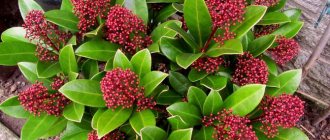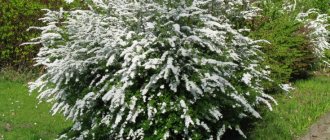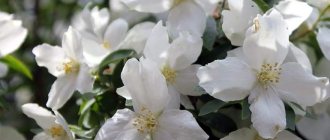Origin
Spiraea, also known as meadowsweet, belongs to the Rosaceae family and is an ornamental shrub. The plant is distinguished by the flexibility of its stems, for which it received its name - “speira” translated from ancient Greek means “bend”. The genus includes about a hundred species of spirea, growing in forest-steppe, steppe zones and even in semi-deserts. It is not for nothing that meadowsweet is considered a very unpretentious plant.
Spiraea in bloom
The name “meadowsweet” was much more common in ancient times than spirea. Under this name, the shrub is mentioned in the epic “Sadko” and in the works of V.I. Dahl, who reported that the stems of the plant, due to their strength, are used to make ramrods and whips.
The spirea bush also has a name - bride. It refers to varieties with white flowers. The same plant has variant names “spray bush” and “spirea bush”.
Diseases and pests
Spiraea Bride is little susceptible to diseases and pest attacks; it has high phytoncidal activity and is able to protect itself and the plants nearby. Defeat occurs when the immune system is weakened. In damp, cloudy weather, there is a high risk of fungal infections, which can be easily treated by treating with Bordeaux mixture and removing the affected parts of the plant. Among the insects that are dangerous for the Bride spirea are aphids, blue sawflies, bud gall midges, and spider mites. The most effective in combating them are “Phosfamide”, “Fitoverm”, “Karbofos”, a combination of granulated “Pirimora” and “Bitobaxillin”. The Bride is saved from snails and slugs by the mulch around the trunk.
Appearance of the plant
The external features of the spirea shrub depend on the specific species. For example, the height of the stems varies from 15 cm to 2.5 m. The stems of meadowsweet can be either erect or creeping, from light to dark brown in color. The bark may peel off longitudinally.
Japanese and gray spirea - description, planting and care
The root system is fibrous and is usually located shallow.
Spiraea leaves are petiolate, alternately arranged, three- or five-lobed. The shape of the plates is lanceolate or round.
The inflorescences are spike-shaped, corymbose, pyramidal or paniculate, consisting of many small flowers. They are located, depending on the type, along the edges, in the middle or entirely along the branches. The color of the flowers ranges from deep burgundy to pure white.
Note! As an ornamental plant, spirea is universal - it looks great both alone and as an element of a hedge or flower bed.
Spiraea White Bride in landscape design
Beginning gardeners who have not previously seen the Bride spirea need only look at the photo and read the description to immediately fall in love with it. The shrub is used in single plantings to create landscape compositions, decorate hedges and the banks of reservoirs. The combination of White Bride spirea and coniferous crops is considered traditional. A composition of several varieties against the background of a lawn looks impressive. Designers like to plant Wangutta separately so that nothing overshadows its beauty. The plant is resistant to soil and air pollution, which allows it to be used in urban landscaping and planted in industrial areas. The White Bride Bush can be cut into any shape, but in this case it will not bloom.
Spring-blooming spirea
Japanese quince shrub - description of the plant and fruits
Shrub species that open their flowers in spring are heavily bushy. Inflorescences appear only on second-year branches. The petals of spring spirea are distinguished by their delicate colors. Gardeners love these varieties of meadowsweet for their early flowering.
Spiraea Wangutta
A hybrid obtained by crossing Cantonese and three-lobed spirea. Blooms at the very beginning of summer. Hemispherical inflorescences are located throughout the branch; they consist of small (about 6 mm) white flowers.
The bush itself is quite tall - up to 2 m. The branches are drooping, dotted with three-lobed, serrated bare leaves. The plates are dark green on top and bluish on the bottom. In autumn they acquire a wonderful orange color.
Spiraea Wangutta
For its delicate coloring and graceful curves, this plant is often called the “bride bush.” However, this name is also extended to other species and varieties of spirea that have white or light-colored flowers.
Spiraea oakleaf
A tall (up to 2 m) variety of spirea, with gracefully bending branches, strewn with white inflorescences during flowering.
This shrub is also called the bride; the plant fully lives up to its popular name, not only with its beauty, but also with its splendor. Due to its spreading branches, it requires quite a lot of space.
oakleaf meadowsweet
Spiraea nipponensis
This spirea is called Nippon, that is, Japanese, because of its place of origin - the island of Honshu. The shrub is quite tall, up to 180 cm, dense branches are located horizontally. Green leaves, up to 4.5 cm long, do not change their color until late autumn.
The inflorescences are corymbose, dense, and consist of greenish-yellow flowers, while the unopened buds are pink. Nippon spirea blooms from the first days of June to mid-summer.
Nippon spirea
Spiraea thunberg
This is an elegant shrub up to 1.8 m tall, with small dark green leaves that turn orange-red in autumn. The inflorescences are umbellate, located along the entire length of the branches. The flowers are small, snow-white, shaped like stars.
Thunberg's meadowsweet
Spiraea crenate
A low shrub (about 1 m) with white flowers collected in corymbose inflorescences. The leaves are dark green, with three prominent veins. Flowering duration is approximately 20 days. Frost-resistant, tolerates shading well, but produces more inflorescences in sunny places.
Crenate variety of bride
Spiraea gray
An interesting hybrid, the result of crossing St. John's leaf and whitish-gray spirea. The height of the bush is about 180 cm. The branches are drooping, with greenish-gray (bluish below) lanceolate leaves. The gray spirea shrub got its name from their color. Blooms from the second decade of May to mid-June.
Gray spirea
The flowers are bright white, collected in corymbose inflorescences located along the entire length of the branches.
Recommendations for growing spirea in various climatic zones of Russia
Many varieties of spirea are undemanding in care, so they can be successfully grown in central Russia and even withstand harsh winters with temperatures down to -25 °C. This is due to the fact that modern varieties are adapted to different climatic conditions.
Ural and Siberia
The climate in the Urals is harsh. Almost all types of spirea will grow well in its southern part. For growing shrubs in the middle zone and in the north, it is recommended to choose frost-resistant varieties. The same applies to growing spirea in Siberia. Only low-growing varieties will be able to survive the winter under the snow without major losses. If medium- and tall-growing plants are not covered, then some of the shoots are guaranteed to be frostbitten, and in such conditions it is impossible to achieve decorative and abundant flowering.
Although many species tolerate frost well, preference should be given to the most frost-resistant plants. Most Popular:
- Spiraea gray Grefsheim;
- Spiraea willow;
- Pink spirea (Rosea).
Moscow region and central Russia
Almost all varieties and types of spirea are suitable for growing in central Russia. Shrubs such as Japanese spirea and Nippon spirea need additional shelter for the winter.
Summer-blooming spirea
Spiraea - species and varieties with white and pink flowers
Spireas, which bloom in summer, have one peculiarity: flowers appear on young shoots, while old ones dry out over time. Among the variety of species, Japanese spirea stands out especially, the varieties of which have gained particular popularity among gardeners.
Spiraea looseleaf
Tall (up to 2 m) shrub with straight brownish-brown shoots. The leaves are pointed, about 10 cm long. The inflorescences are paniculate-pyramidal, up to 20 cm in length, consisting of whitish or pink small flowers.
Meadowsweet
Spiraea white-flowered
A fairly tall shrub (up to 1.5 m) with fragrant white flowers. Pleases with flowering from mid-summer. One of the few types of summer-flowering spirea with white petals.
White-flowered bride
Spiraea japonica
The Japanese spirea shrub has a height of 100 to 150 cm. The shoots appear pubescent, but as they grow, they become bare. The leaves are ovate, oblong, green on top and bluish on the underside. Corymbose-paniculate inflorescences are formed along the edges of the branches and consist of small purple flowers.
Japanese spirea usually blooms in July.
Japanese meadowsweet
Many people confuse the name of spirea, mistakenly calling it Chinese. It is worth remembering that the birthplace of this shrub is Japan.
Spiraea douglas
Shrub, up to one and a half meters high, with red-brown shoots pubescent on top. The leaves are oblong-lanceolate, from 3 to 10 cm in length. The inflorescences of Douglas spirea are paniculate-pyramidal, collected from dark pink flowers.
Spiraea douglas
The beauty of the inflorescences can be enjoyed from June to mid-July and early August.
Spiraea Boumalda
This is a miniature (about 50 cm) hybrid of Japanese and white-flowered meadowsweet. The stems are erect, dotted with green leaves, which become brightly colored in autumn. Blooms from July to late August.
Meadowsweet Boumalda
The petals can be colored in tones from soft pink to red, depending on the variety.
Spiraea Billarda
A hybrid from crossing Douglas spirea and willow spirea. It can reach a height of 2 m. The leaf blades are broadly lanceolate in shape, about 10 cm long. Narrow pyramidal paniculate inflorescences, collected from bright pink flowers, can reach a length of 20 cm.
Spiraea Billarda
The shrub blooms from the second half of July.
The most popular varieties of Japanese spirea
Japanese varieties of spirea are very popular. Among them are spirea Goldflame, Anthony Waterer, Golden Princess and many others. It is worth learning more about this group of plants.
Japanese Anthony Waterer
A compact shrub with a dense crown and very bright flowers, painted in a carmine shade. The flowering period lasts up to 3 months. It coincides with that of hydrangea, so you can plant these crops together - the picture turns out spectacular.
Experts also advise using this spirea in discounts. Frost resistance zone – 4.
Japanese Golden Princess
A dwarf shrub whose height does not exceed 50 cm. It stands out due to its incredibly beautiful flowers. The leaves are bright yellow, but can change color at different times of the year.
Japanese Genpei
A good option for those who want to add variety to their site. The plant retains its decorative properties throughout the winter, and requires minimal care.
The height of the bush reaches 80 cm. The flowering is unusual, tricolor: the flowers are white, pale pink and lilac-red. They begin to open in July and last until September.
Genpei has good immunity and the ability to adapt to urban conditions.
Replanting in the ground after purchase
Spiraea can be planted both in spring and autumn, and in spring only summer-flowering varieties of shrubs are planted. It is very important to have time to plant the bride before the buds bloom on the shoots.
When purchasing seedlings in a store, you need to inspect the roots and shoots. If they are strong enough and not damaged, you can safely plant shrubs on the site.
In autumn, spirea is planted before the end of leaf fall. For planting, they usually take bushes that are 3-4 years old. They are optimal for dividing.
What you will need
To plant spirea you will need:
- Scissors for cutting off excess roots;
- Shovel;
- Drainage (for example, broken brick);
- soil mixture;
- Water for irrigation;
- Peat;
- Secateurs.
Important! In autumn, you can plant both spring-flowering and summer-flowering spirea.
Optimal place
Despite the general unpretentiousness of the shrub, it is advisable to choose a well-lit, spacious place for it with soil rich in nutrients.
If the choice is small, meadowsweet can also be planted on a rocky area, in partial shade near a fence, gate or next to other shrubs.
Worth remembering! The more spacious and lighter the plant, the more magnificent and longer it will bloom.
Planting process
Spring planting of the bride bush step by step:
- A hole is prepared on the site, the volume of which is about a third larger than the volume of the root system of the seedling. It is advisable to do this a couple of days before the planned planting.
- Before planting, the seedling is placed in a bucket with a small amount of water.
- Drainage is laid out at the bottom of the hole, in a layer of about 20 cm.
- Combine 2 parts of leaf soil with 1 part sand and 1 part peat. Pour the resulting mixture into the bottom of the hole.
- Place the seedling in the hole and carefully straighten the roots. Cover them with soil, gently compacting them with your hands. The root collar should be flush with the soil surface.
- Water the seedling with water (this will take 18-20 liters) and mulch the tree trunk circle with peat.
Planting in spring
Autumn planting of spirea in stages:
- Dig a three or four year old bush out of the ground.
- Wash the root system in running water.
- Using pruning shears, divide the bush into 3 parts.
- Prepare planting holes.
- Place drainage at the bottom and add soil mixture.
- Plant the plants, carefully cover the roots with soil and compact them.
- Water the plantings generously.
Important! It is best to choose a cloudy day for planting.
Mr. Summer Resident advises: pruning spirea
Without timely pruning, spirea looks unkempt; dry and weak branches prevent the formation of new shoots. To give the bush a decorative appearance, it is regularly pruned. Thanks to this, the plant forms powerful shoots and many inflorescences, allows more light and air to pass through, and reduces the risk of attack by pests and diseases.
In early spring, before the buds open, sanitary pruning is carried out. Frozen, diseased, thin, broken, dried branches are cut out from spirea. After flowering ends, spring varieties are immediately pruned and dry inflorescences are removed. New shoots with bright green leaves are removed from Japanese spirea.
For early bloomers, older than 3-4 years, stimulating pruning is carried out and in the fall they are cut to a quarter of the length. The plant can be given any shape desired (ball, square, triangle).
It is recommended to feed with mineral mixtures after the procedure.
Summer flowering plants need stimulating pruning from 3-4 years of age. Remove weak, diseased, old branches to the neck level with sharp pruning shears in the fall, half a month before frost, leaving 2-3 buds.
For spirea older than 7 years, anti-aging pruning is also carried out 2-3 weeks before frost. All branches are cut to the soil level, leaving 30 cm. In spring, the bush forms young shoots.
Reproduction of spirea
It is best to propagate spirea by cuttings, since hybrid varieties do not retain their characteristics when propagated by seed.
Cuttings
Spring-flowering plants are cut in early June, summer-flowering plants - in July. It is best to root cuttings in September-October.
Cuttings of spirea:
- Cut the one-year-old straight stem and divide it into pieces, so that each leaves 5-6 leaves.
- Remove the lower leaves along with the cuttings, shorten the upper ones by half.
- Place the cuttings in Epin solution for 12 hours.
- Dip the lower node into Kornevin's solution and plant the cutting in a container with moistened sand so that it is inclined at an angle of 30-45°.
- Cover the container with film or glass and put it in a dark place.
- Spray twice every day with a spray bottle, making sure that the sand remains moist.
After the onset of frost, the cuttings are buried in the area, covered with leaves and an inverted box is placed on top. They are left in this position until spring.
Bride's Bush Seeds
When new shoots appear on the plants, you can replant them in a permanent place.
Seeds
In the summer, unopened but already drying seed pods are collected from spirea species. The fruits are sent to ripen for a couple of weeks in a dry place (for example, in an open box).
After the specified time, the spilled seeds are collected and stored in a fabric bag until spring.
In April, the seeds are sown in a box with soil, sprayed with a spray bottle and, covered with glass, the container is sent outside. It is necessary to ensure that the soil does not dry out, but that there is no stagnation of moisture. When shoots appear, the glass can be removed.
When they reach a height of 2 cm, the seedlings are picked, selecting the strongest ones, and planted in a box, at a distance of 5-6 cm from each other. In autumn they can be planted in permanent places.
Important! Spiraea, obtained from seeds at home, begins to bloom already in the 3rd year of growth.
Plant care
Light-loving spirea loves loose, nutritious soils. However, the plant is unpretentious in care and does not show any special “whims”.
Watering
Water the bush in dry times once a week for 14 days, 1.5 buckets of water per bush. In rainy weather, watering is reduced.
Top dressing
Spirea is fed with complex mineral fertilizer in the spring. In summer, the bush is fertilized with a solution of mullein with the addition of 10 g of superphosphate per bucket of liquid.
Rest period
When the bush fades and autumn arrives, it’s time to start pruning. Old bushes are pruned, leaving stumps with 2-3 buds. On young shrubs, thickening the crown or diseased shoots are removed.
Plant pruning diagram
The soil at the roots is carefully loosened and fertilized if necessary. Any composition is suitable, except those containing nitrogen and mullein. The ground under the bush is watered abundantly.
Preparing for winter
The roots of spirea can withstand the cold well, so it can winter without shelter. However, if too severe frosts are expected, the plant is sprinkled with dry foliage for the winter, in a layer of up to 15-20 cm.
Spirea is an excellent choice for beginners, because this shrub does not require complex care. But you can admire the flowering of this elegant plant for a long time. There will also be no problems with propagation and rooting, so spirea can be generously shared with neighbors.
Landing
The most favorable time would be to plant in September in cloudy or even rainy weather , while the soil is saturated with moisture, and also before the leaves begin to fall. Preferably light, fertile, well-drained soils with a pH level not higher than 7, then plant care is reduced to a minimum.
If the soil does not meet the requirements, its composition can be adjusted:
- Soak heavy soils with ash (1 cup per 1 sq. m.).
- Depleted - saturate by mixing humus, fertilizers and peat (fertilizers to water should be in a ratio of one to two).
- High acidity - can be reduced with lime or dolomite flour (300 g per 1 sq. m.).
The place chosen is sunny and, most importantly, with deep groundwater . Despite the fact that spirea love moisture, there should be no water near the roots when planting. Therefore, drainage (gravel or crushed stone) is poured into a spacious hole 50x50 cm in a layer of 10–15 centimeters. The top is covered with soil and the seedling is placed on it, while evenly leveling the roots. Carefully pour 2 buckets of water into the hole and distribute the remaining soil, pre-mixed with a substrate consisting of peat and a turf-leaf mixture. The root collar is not deepened, but left 1 cm above the surface. The trunk is covered with mulch to avoid moisture evaporation. Already in the third year the bush will begin to bloom .
Selection of planting material
Seedlings must be healthy, young and compact, without open buds . The roots should be flexible, without visual damage or blackening, and well branched. The shoots of the seedling are flexible, green, without cracks and with healthy buds.
Important! If you purchase a seedling with a closed root system, it will take root more easily even with leaves and blossoming buds on it.
If the root does not have a sufficient number of branches, it must be soaked for a day in any root-forming solution. Planting material should not have rotten areas, diseases or damage by pests.
Preparing the landing site
As with most flowering shrubs, an important criterion for spirea to bloom is a large amount of sunlight throughout the day. The shrub can also grow in a shaded place, but the growth of shoots will be slowed down, which will negatively affect its ability to reproduce and decorative functions . Over time, the plant will grow significantly, so the diameter around the planting site of one bush should be at least 3 m. If we are talking about group planting, then the distance between the bushes reaches at least 1.5 m.











